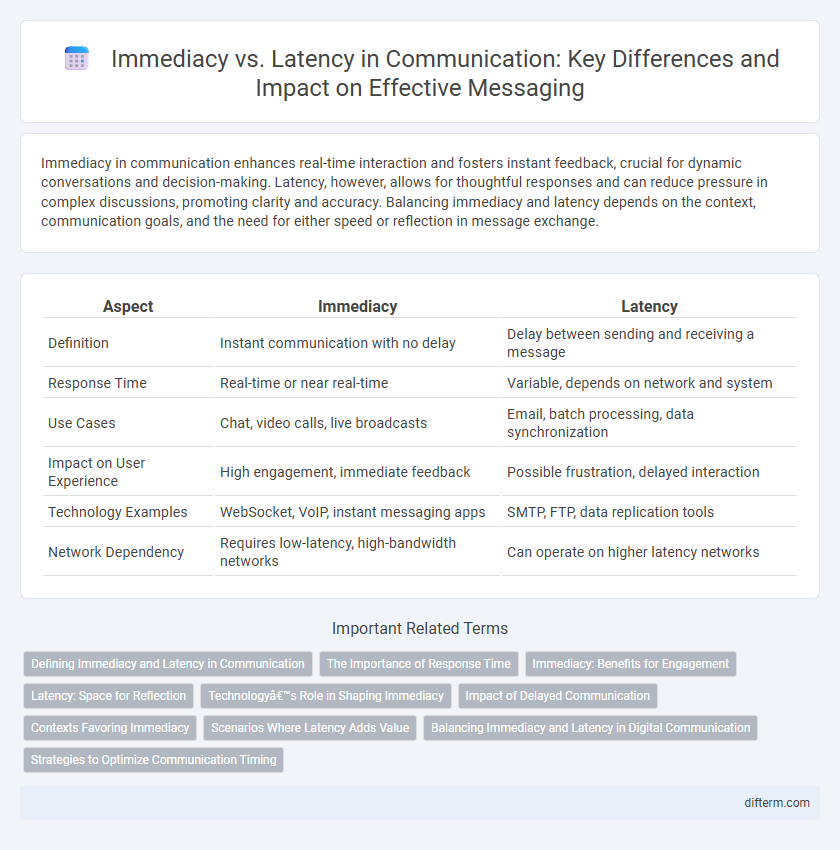Immediacy in communication enhances real-time interaction and fosters instant feedback, crucial for dynamic conversations and decision-making. Latency, however, allows for thoughtful responses and can reduce pressure in complex discussions, promoting clarity and accuracy. Balancing immediacy and latency depends on the context, communication goals, and the need for either speed or reflection in message exchange.
Table of Comparison
| Aspect | Immediacy | Latency |
|---|---|---|
| Definition | Instant communication with no delay | Delay between sending and receiving a message |
| Response Time | Real-time or near real-time | Variable, depends on network and system |
| Use Cases | Chat, video calls, live broadcasts | Email, batch processing, data synchronization |
| Impact on User Experience | High engagement, immediate feedback | Possible frustration, delayed interaction |
| Technology Examples | WebSocket, VoIP, instant messaging apps | SMTP, FTP, data replication tools |
| Network Dependency | Requires low-latency, high-bandwidth networks | Can operate on higher latency networks |
Defining Immediacy and Latency in Communication
Immediacy in communication refers to the real-time exchange of information, enabling instant feedback and interaction between participants. Latency denotes the delay between message transmission and reception, affecting the flow and responsiveness of conversations. Understanding the balance between immediacy and latency is crucial for optimizing communication effectiveness across various platforms.
The Importance of Response Time
Response time plays a critical role in effective communication, directly influencing the clarity and engagement between participants. Immediacy facilitates real-time interaction, reducing misunderstandings and fostering stronger connections, whereas latency can hinder message flow and delay decision-making processes. Optimizing response speed enhances collaboration, trust, and overall communication efficiency in both personal and professional contexts.
Immediacy: Benefits for Engagement
Immediacy in communication enhances engagement by fostering real-time interaction and instant feedback, which strengthens connection and improves message clarity. High immediacy reduces misunderstandings and encourages active participation, critical in dynamic environments like customer support and collaborative teamwork. This immediate responsiveness leads to increased trust and satisfaction, driving better overall outcomes.
Latency: Space for Reflection
Latency in communication creates essential space for reflection, allowing individuals to process information deeply before responding. This delay enables thoughtful analysis, reduces impulsive reactions, and enhances the quality of discourse. Effective latency management improves understanding and supports more meaningful exchanges in both personal and professional interactions.
Technology’s Role in Shaping Immediacy
Technology has drastically reduced communication latency by introducing real-time messaging platforms, video conferencing tools, and instant notification systems, enabling instantaneous exchange of information across the globe. Advances in 5G networks and edge computing further enhance immediacy by minimizing data transmission delays and supporting ultra-responsive applications. These innovations empower businesses and individuals to make faster decisions, collaborate efficiently, and maintain continuous connectivity in an increasingly digital world.
Impact of Delayed Communication
Delayed communication significantly hampers decision-making processes and reduces overall organizational efficiency by creating information bottlenecks. It increases the risk of misunderstandings and errors, which can compromise project timelines and stakeholder trust. Prolonged latency in communication channels often results in missed opportunities and escalated operational costs due to slower response rates.
Contexts Favoring Immediacy
Contexts favoring immediacy prioritize real-time interactions where swift feedback enhances understanding, such as in emergency response, live customer support, or collaborative remote work. These scenarios demand minimal latency to ensure timely decision-making and maintain communication clarity. Organizations leveraging instant messaging, video conferencing, or live chat platforms benefit from immediacy to foster engagement and resolve issues rapidly.
Scenarios Where Latency Adds Value
Latency can enhance communication quality in scenarios requiring thoughtful reflection, such as email exchanges and formal proposals, where delayed responses allow for careful drafting and error correction. It supports asynchronous collaboration by accommodating diverse time zones and schedules, enabling participants to contribute without time pressure. Latency also aids in conflict resolution by providing space for emotional cooling, which can lead to more constructive and measured dialogue.
Balancing Immediacy and Latency in Digital Communication
Balancing immediacy and latency in digital communication is essential for optimizing user experience and system efficiency. Immediate responses enhance real-time interaction and engagement, while controlled latency can reduce system overload and improve scalability. Effective communication platforms strategically manage this balance by prioritizing urgent messages and queuing less critical data to maintain seamless connectivity.
Strategies to Optimize Communication Timing
Effective communication requires balancing immediacy and latency to enhance message delivery and comprehension. Strategies such as leveraging real-time messaging platforms for urgent interactions and scheduling asynchronous updates for non-critical information help maintain workflow efficiency. Implementing clear guidelines on response times and prioritizing communication channels based on message urgency optimizes overall timing and reduces misunderstandings.
immediacy vs latency Infographic

 difterm.com
difterm.com